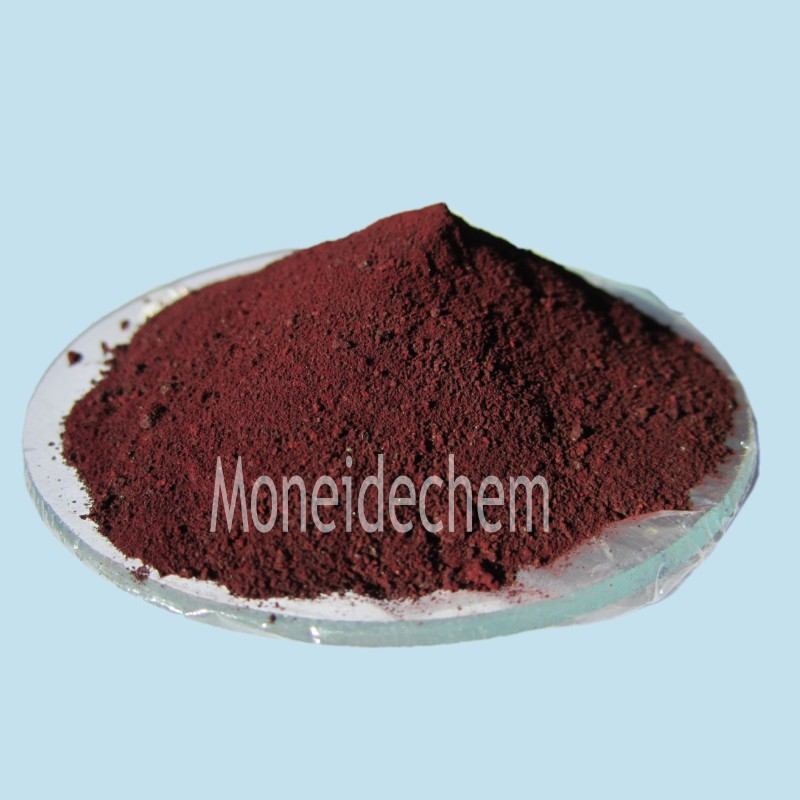Moneide Chemicals
Tel: 86-315-8309571
WhatsApp/WeChat/Mobile: 0086-15633399667
Skype: janet-honest
Mail: sales@moneidechem.com
Address: 2-7-523 Jidong Building Materials Tangshan, Hebei 064000 China
|
Chemical Name |
Phenol Red |
|
CAS No. |
143-74-8 |
|
Molecular formula |
C19H14O5S |
|
EINECS № |
205-609-7 |
|
Molecular weight |
354.38 |
|
Molecular Structure |
|
|
Details |
Appearance: Tender red or carmine crystal powder. PH change range: 1.2(orange)~3(yellow); 6.5(yellow)~8(viole) Maximal absorption wavelength(nm): λ1(PH1.2) 503-506 λ2 (PH3.0) 430-435 λ3 (PH6.5) 430-435 λ4 (PH8.0) 557-560 Quality absorption coefficient(L/cm·g): α1[λ1(PH1.2,dry sample)] 110~123 α2[λ2(PH3.0,dry sample)] 60~68 α3[λ3(PH6.5, dry sample)] 62~72 α4[λ4(PH8.0,dry sample)] 120~135 Solubility in alkali: Passes test Loss on drying: 1.0% max Sulfated ash: 0.2% max Solubility:easy solve in alkali solution,alcohol&acetone, not solve in water. Packing: 25kg/ fibre drum. |
|
Main Application |
Acid and alkali indicator. |
1. What is phenol red used for?
Phenol red is a pH indicator widely used in cell culture media to monitor metabolic activity and pH changes. Its color shifts from yellow (acidic, pH <6.8) to red (neutral, pH 6.8-8.2) and pink/red-violet (alkaline, pH >8.2), helping researchers detect acid production (e.g., from bacterial fermentation) or alkaline shifts. It’s also employed in urine pH tests, kidney function studies, and as a dye in diagnostic kits. In microbiology, it helps identify carbohydrate fermentation in culture media, such as in phenol red broth tests for distinguishing bacterial species.
2. Is phenol red bad for you?
Phenol red is generally considered non-toxic at low concentrations but is not intended for ingestion. In cell culture, it can weakly mimic estrogen, potentially interfering with sensitive hormonal studies, prompting some researchers to use phenol red-free media. Prolonged exposure to high concentrations may cause mild irritation to skin or eyes. While not classified as highly hazardous, its synthetic nature warrants careful handling in labs. Regulatory agencies approve its use in diagnostics but restrict it from food or cosmetic applications due to insufficient safety data.
3. What does a phenol red test indicate?
A phenol red test primarily indicates pH changes due to metabolic activity. In microbiology, it detects acid/alkaline byproducts from bacterial fermentation of sugars (e.g., lactose or glucose). A yellow color signals acid production, while pink suggests alkaline metabolites. In cell culture, prolonged yellowing indicates harmful acidity from overgrowth or contamination. In urology, phenol red urine tests assess kidney function by measuring pH or tubular secretion rates. The test’s simplicity makes it a staple in both clinical and research settings for rapid metabolic screening.
4. What are phenol red tablets used for?
Phenol red tablets are pre-measured reagents dissolved in water or media to create pH indicator solutions. They’re commonly used in educational labs for acid-base titration experiments, in aquarium maintenance to monitor water pH, and in medical diagnostics for urine pH tests. The tablets standardize concentrations, ensuring consistent results in bacterial culture media (e.g., phenol red carbohydrate broths). Their portability also makes them useful for field tests, such as checking pH in environmental water samples or veterinary diagnostics.


























